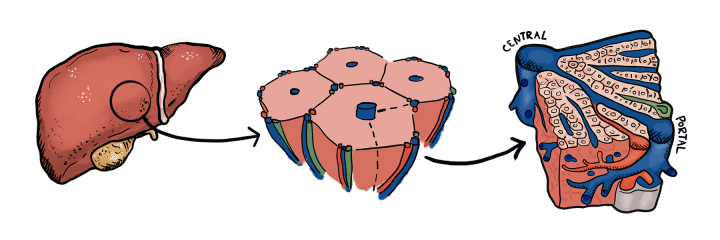Sequencing single cells uncovers potential liver disease drug target
October 2019: Researchers have discovered a subgroup of cells which provide a promising target for chronic liver disease therapies.
A liver cell type called the hepatic stellate cell (HSC) was found to be the main cause of scarring in the liver 35 years ago. Until recently, all cells of this type were thought to have the same function.
By using a technique called single cell RNA sequencing, scientists at the Centre for Inflammation Research were able to show that HSCs are made up of two subgroups which have different zones and roles in the liver. One subgroup is found next to branches of the central vein and has a key role in producing scar tissue following liver injury.

The researchers then found that the level of scarring in the liver could be reduced by targeting a protein made by the cells called LPAR-1. This protein is not produced by other liver cells and so could be used as a therapy target without other side effects in the liver. They showed that LPAR-1 is made in increasing amounts in patients with non-alcoholic steatohepatitis (NASH), which is a type of non-alcoholic fatty liver disease where liver cells become inflamed.
Using this new technology has allowed us to identify the key scar-forming cells in the liver. Importantly, it has yielded key molecular targets and pathways which are amenable to drug therapy. These types of approaches should rapidly accelerate the discovery of much-needed new treatments for patients with liver disease
There are currently no treatments available for NASH, which is on the rise in Scotland. It is hoped that this discovery of HSC subgroups and a potential therapy target may lead to progress for the huge number of people living with chronic liver disease worldwide.
This research was conducted as a collaboration between The University of Edinburgh, the Karolinska Institutet, Gilead Sciences, the Wellcome Trust Sanger Institute, The European Bioinformatics Institute (EMBL-EBI) and the University of Cambridge. It was funded by a Wellcome Trust Senior Fellowship in Clinical Science, a Guts UK - Children's Liver Disease Foundation grant and a Tenovus Scotland grant.
What is single cell RNA sequencing?
Single cell RNA sequencing is a cutting-edge laboratory approach which allows measurement of gene expression levels across thousands of individual cells. Whereas DNA is a storage device for genetic information, RNA `reads’ DNA to perform various functions. RNA sequencing therefore gives more information about which genes are active in a cell at a given time. This allows scar-forming cells and molecules to be identified.

